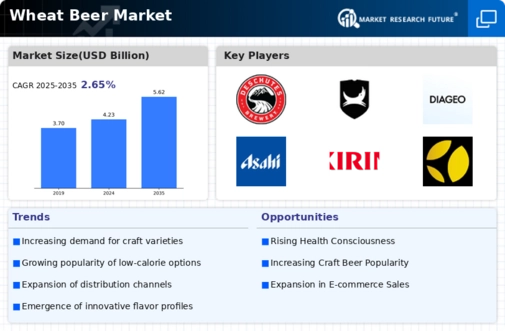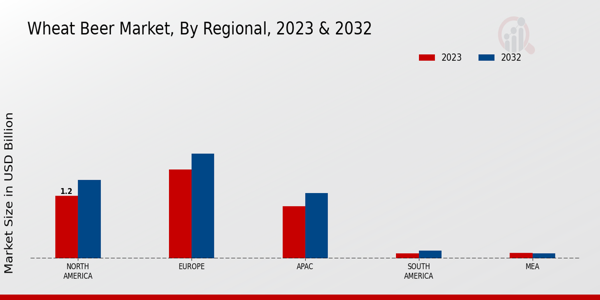Market Growth Projections
Innovative Brewing Techniques
The Global Wheat Beer Market Industry is witnessing a surge in innovative brewing techniques that enhance flavor profiles and overall quality. Breweries are increasingly experimenting with various ingredients, such as fruits and spices, to create unique wheat beer varieties. This innovation not only attracts adventurous consumers but also fosters brand loyalty among those seeking novel experiences. Furthermore, advancements in brewing technology enable producers to maintain consistency and quality, which is crucial in a competitive market. As these innovations continue to emerge, they are likely to drive market growth, contributing to the anticipated increase in market value to 5.62 USD Billion by 2035.
Expansion of Distribution Channels
The Global Wheat Beer Market Industry is experiencing an expansion of distribution channels, which plays a crucial role in enhancing product accessibility. With the rise of e-commerce and online retail platforms, consumers can easily purchase a variety of wheat beers from the comfort of their homes. Additionally, traditional distribution channels, such as supermarkets and specialty liquor stores, are increasingly stocking a wider range of wheat beer options. This diversification in distribution not only caters to consumer preferences but also supports market growth by reaching a broader audience. As these channels continue to evolve, they are likely to contribute to the overall expansion of the wheat beer market.
Growing Popularity of Beer Festivals
Beer festivals have become a cultural phenomenon, significantly impacting the Global Wheat Beer Market Industry. These events provide a platform for breweries to showcase their products, allowing consumers to sample a diverse range of wheat beers. The social aspect of beer festivals fosters community engagement and encourages consumers to explore new brands and flavors. As attendance at such festivals continues to rise, breweries benefit from increased visibility and sales opportunities. This trend not only enhances consumer awareness but also stimulates demand for wheat beers, potentially propelling the market towards its projected growth trajectory.
Rising Consumer Preference for Craft Beers
The Global Wheat Beer Market Industry experiences a notable shift as consumers increasingly gravitate towards craft beers, which are perceived as unique and high-quality alternatives to mass-produced options. This trend is particularly evident in regions such as North America and Europe, where craft breweries are flourishing. The allure of artisanal brewing methods and distinctive flavors appeals to a diverse demographic, including millennials and Gen Z. As a result, the market is projected to reach 4.23 USD Billion in 2024, reflecting a growing demand for innovative wheat beer offerings that cater to evolving consumer tastes.
Health Consciousness and Low-Calorie Options
In recent years, there has been a marked increase in health consciousness among consumers, influencing their beverage choices. The Global Wheat Beer Market Industry is responding to this trend by introducing low-calorie and gluten-free wheat beer options. These products cater to health-oriented consumers who seek flavorful alternatives without compromising their dietary preferences. The rise of health-focused marketing strategies is likely to enhance the appeal of wheat beers, potentially boosting market growth. As the industry adapts to these consumer demands, it is anticipated that the market will expand, contributing to a projected CAGR of 2.62% from 2025 to 2035.











